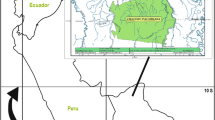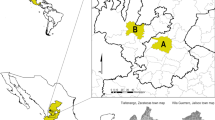Assessing Variation and Diversity of Ethnomedical Knowledge: A Case Study from Malekula Island, Vanuatu
Ethnomedical knowledge is important for health and wellbeing in many rural communities. Bodies of ethnomedical knowledge vary within and between communities, and may be at risk of erosion. However, little work has analyzed knowledge variation in Melanesia. In this study we use structured interview data from 177 participants to analyze richness and diversity of ethnomedical knowledge on Malekula Island in the Republic of Vanuatu. We use an information theoretic approach, a methodology that enables selection between competing hypotheses, and find that ethnomedical knowledge richness is patterned by gender, linguistic preference, and market visitation. We also note that the diversity of ethnomedical knowledge is highest in the oldest, less formally educated participants. These findings may indicate that social and environmental change has impacted the shape and form of ethnomedical knowledge in these communities. In response, we note the importance of vernacular language acquisition for maintenance of ethnomedical knowledge on Malekula. Our approach demonstrates the power of ecological methods, including diversity indices and model selection, for the analysis of ethnobiological data.



Similar content being viewed by others
Literature Cited
Agrawal, A. 2002. Indigenous knowledge and the politics of classification. International Social Science Journal 54(173):287–298.
Begossi, A. 1996. Use of ecological methods in ethnobiology: Diversity indices. Economic Botany 50(3):280–289.
———, N. Hanazaki, and J. Tamashiro. 2002. Medicinal plants in the Atlantic forest (Brazil): Knowledge, use, and conservation. Human Ecology 30(3):281–299.
Benz, B. F., J. Cevallos, F. Santana, J. Rosales, and S. Graf. 2000. Losing knowledge about plant use in the Sierra De Manantlan Biosphere Reserve, Mexico. Economic Botany 54(2):1874.
Berkes, F. 2008. Sacred ecology: Traditional ecological knowledge and resource management, 2nd edition. Taylor and Francis, London.
Boster, J. 1986. Exchange of varieties and information between Aguaruna manioc cultivators. American Anthropologist 88:429–436.
Bourdy, G. and A. Walter. 1992. Maternity and medicinal plants in Vanuatu. I: The cycle of reproduction. Journal of Ethnopharmacology 37:176–196.
Bradacs, G., J. Heilmann, and C. Weckerle. 2011. Medicinal plant use in Vanuatu: A comparative ethnobotanical study of three islands. Journal of Ethnopharmocology 137(1):434–448.
Burnham, K. and D. Anderson. 2004. Multimodel inference: Understanding AIC and BIC in model selection. Sociological Methods and Research 33:261–304.
Cabalion, P., C. Sam, and M. Hoff. 1991. Contribution a l’etude de la flore de Vanuatu. Index synonymique de la flore, liste de specimens d’herbier par especes, listes des especes par ile [Document Interne]. OSRTOM, Port Vila, Vanuatu.
Case, R. J., G. E. Pauli, and D. Soejarto. 2005. Factors in maintaining indigenous knowledge among ethnic communities of Manus Island. Economic Botany 59(4):356–365.
Chang Bioscience. 2011. Shannon-Wiener Diversity Index / Shannon Entropy Calculator. http://www.changbioscience.com/genetics/shannon.html (27 August 2015).
Colwell, R. 2009. EstimateS: Statistical estimation of species richness and shared species samples. Version 8.2 [software].
Crowley, T. 2006. Naman: A vanishing language of Malakula (Vanuatu). Pacific Institute of Linguistics, Australian National University, Canberra.
Early, R. 1999. Double trouble, and three is a crowd: Languages in education and official languages in Vanuatu. Journal of Multilingual and Multicultural Development 20(1):37–41.
Godoy, R., N. Brokaw, D. Wilkie, D. Colon, A. Palermo, S. Lye, S. Sei, D. Colón, and S. Wei. 1998. Of trade and cognition: Markets and the loss of folk knowledge among the Tawahka Indians of the Honduran rainforest. Journal of Anthropological Research 54(2):219–234.
———, V. Reyes-Garcia, J. Broesch, I. Fitzpatrick, P. Giovanninni, M. Rodriguez, T. Huanca, et al. 2009. Long-term (secular) change of ethnobotanical knowledge of useful plants: Separating cohort and age effects. Journal of Anthropological Research 65(c):51–67.
Gotelli, N. J. and R. K. Colwell. 2011. Estimating species richness. Pages 39–54 in A. E. Magurran and B. J. McGill, eds., Biological diversity: Frontiers in measurement and assessment. Oxford University Press, Oxford.
Guest, G. 2002. Market integration and the eistribution of ecological knowledge within an Ecuadorian fishing community. Journal of Ecological Anthropology 6(1):38.
Hunn, E. S. 2002. Evidence for the precocious acquisition of plant knowledge by Zapotec children. Pages 604–613 in J. R. Stepp, F. S. Wyndham, and R. K. Zarger, eds., Ethnobiology and biocultural diversity. International Society for Ethnobiology, Athens, Georgia.
Inc, S. P. S. S. 2008. SPSS for Windows 17.0. SPSS Inc., Chicago.
ISE (International Society of Ethnobiology). 2006. ISE code of ethics (with 2008 additions). http://ethnobiology.net/code-of-ethics/code-in-english/ (27 August 2015).
Lynch, J. and T. Crowley. 2001. Languages of Vanuatu. Pacific Linguists, Canberra.
Magurran, A. E. 2004. Measuring biological diversity. Malden, Massachusetts, and Oxford, U.K: Blackwell Science Ltd.
McCarter, J. and M. C. Gavin. 2011. Perceptions of the value of traditional ecological knowledge to formal school curricula: Opportunities and challenges from Malekula Island, Vanuatu. Journal of Ethnobiology and Ethnomedicine 38(7).
——— and ———. 2014. In situ maintenance of traditional ecological knowledge on Malekula Island, Vanuatu. Society and Natural Resources 27(11):1115–1129.
———, ———, S. Baereleo, and M. Love. 2014. The challenges of maintaining indigenous environmental knowledge. Ecology and Society 19(3).
Nettle, D. and S. Romaine. 2000. Vanishing voices: The extinction of the world’s languages. Oxford University Press, Oxford.
Odeli, E. A., F. M. Pusateri, and G. C. White. 2008. Estimation of occupied and unoccupied black-tailed prairie dog colony acreage in Colorado. The Journal of Wildlife Management 2(6):1311–1317.
Pfeiffer, J. M. and R. J. Butz. 2005. Assessing cultural and ecological variation in ethnobiological research: The importance of gender. Journal of Ethnobiology 25(2):240–278.
Quinlan, M. and R. Quinlan. 2007. Modernization and medicinal plant knowledge in a Caribbean horticultural village. Medicinal Anthropology Quarterly 21(2):169–192.
Regenvanu, R. 2005. The changing face of “custom” in Vanuatu. People and Culture in Oceania 20 (Special edition).
Reyes-Garcia, V., V. Vadez, E. Byron, L. Apaza, W. R. Leonard, L. E. Perez, and D. Wilkie. 2005. Market economy and the loss of folk knowledge of plant uses: Estimates from the Tsimane’ of the Bolivian Amazon. Current Anthropology 46(4):651–656.
———, ———, S. Tanner, T. Huanca, W. R. Leonard, and T. McDade. 2006. Measuring what people know about the environment: A review of quantitative studies. Tsimane Amazonian Panel Study Working Paper #21. http://people.brandeis.edu/~rgodoy/workingpapers/TAPS-WP-21-TEKMETHODS-Jan-2006.pdf.\
Smith, J. 1993. Using ANTHROPAC 3.5 and a spreadsheet to compute a freelist salience index. Cultural Anthropology Methods Letter 5:1–3.
Spellerberg, I. F. and P. J. Fedor. 2003. A tribute to Claude Shannon (1916–2001) and a plea for more rigorous use of species richness, species diversity and the “Shannon-Wiener” Index. Global Ecology and Biogeography 177–179.
Vari-Bogiri, H. 2005. A sociolinguistic survey of Araki: A dying language in Vanuatu. Journal of Multilingual Multicultural Development 26(1):52–66.
Voeks, R. A. and A. Leony. 2004. Forgetting the forest: Assessing medicinal plant erosion in eastern Brazil. Economic Botany 58(Supplement):S294–S306.
Walter, A. and V. Lebot. 2007. Gardens of Oceania. ACIAR, Canberra.
World Health Organization. 2008. Fact sheet on traditional medicine. http://www.who.int/mediacentre/factsheets/fs134/en/ (27 August 2015).
Zarger, R. K. and J. R. Stepp. 2004. Persistence of botanical knowledge among Tzeltal Maya children. Current Anthropology 45(3):413–418.
Zent, S. and E. Zent. 2004. Ethnobotanical convergence, divergence and change among the Hopi of the Venezuelan Guyana. Pages 37–78 in J. Carlson and L. Maffi, eds., Ethnobotany and the conservation of biocultural diversity. New York Botanical Garden Press, New York.
——— and L. Maffi. 2009. Final Report on Indicator No. 2: Methodology for developing a vitality index of traditional environmental knowledge (VITEK) for the project “Global Indicators of the Status and Trends of Linguistic Diversity and Traditional Knowledge.” Terralingua. http://terralingua.org/projects/vitek/VITEK_Report.pdf (3 March 2009).
Acknowledgments
The authors gratefully acknowledge the generous assistance of collaborators in Vanuatu, in particular VCC fieldworkers in the focus communities. Both authors were based at Victoria University of Wellington, New Zealand, while this work was completed. JM was supported by the Ryoichi Sasakawa Young Leaders Fellowship.
Author information
Authors and Affiliations
Corresponding author
Electronic supplementary material
Below is the link to the electronic supplementary material.
ESM 1
(DOCX 19 kb)
Rights and permissions
About this article
Cite this article
McCarter, J., Gavin, M.C. Assessing Variation and Diversity of Ethnomedical Knowledge: A Case Study from Malekula Island, Vanuatu. Econ Bot 69, 251–261 (2015). https://doi.org/10.1007/s12231-015-9319-6
Received:
Accepted:
Published:
Issue Date:
DOI: https://doi.org/10.1007/s12231-015-9319-6




